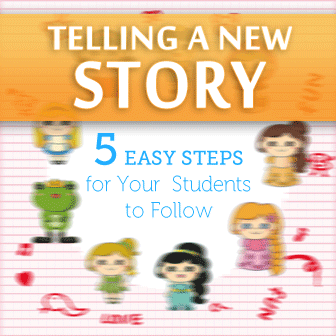Some students are natural writers. Their imaginations take them away to exotic and outrageous places with characters as real as the person sitting next to them. For the greater part however, students need more guidance when attempting to write a fictional piece.
These 5 simple steps are designed with those students in mind. By taking one piece of a story at a time, even the most reluctant writer can tap into the novelist within!

How to Tell a New Story: 5 Easy Steps
-
1
Setting
Choosing a setting for their story is a good place for ESL students to start. You may suggest a setting to them, like a classroom or their home country or even a backyard, or let them choose their own. Who comes up with the idea really does not matter; what matters is what the writer does with it. To make the setting as tangible as possible, have your students write sensory descriptions of where their story will take place. You may want to start by brainstorming a list of adjectives that appeal to each of the senses. Ask your students what words they know that can describe how a place looks, how it sounds, how it smells, feels and tastes. Then, using those lists, ask your students to describe their story setting paying attention to how each sense takes it in. Reassure your students that they can use many more adjectives than those that appear on your brainstormed lists, but those lists are a good place to start if they are stuck for ideas.
-
2
Character
Now that your students know where their story takes place and are familiar with the sounds, smells and sights of that place, ask them to use their imaginations to look around. As they do, have them make note of all the people and creatures that are present in their setting. For example, if their story will be set in a backyard, do they see squirrels? Insects? Boys playing baseball or girls making mud pies? Challenge your students to list at least ten people or creatures that might be present in their setting (real or fantastical) and then choose one as the main character of their story. With that main character, now, have your students assign what they believe to be two good character traits (honesty, bravery, generosity, etc.) and one bad character trait (selfishness, greed, laziness, etc.). By assigning both good and bad qualities to the character, he or she will be a far more interesting and relatable protagonist. You may want your students to write a character sketch, but that is not necessary as long as they get a good feel for whom their character is before they start writing.
-
3
Conflict
Your students know where their story happens and who the main character is, now challenge them to think of a conflict that the character could have. An easy way to do this is to give your students one minute to list as many different problems as they can think for their character in that setting. Are they lost? Do they need food? Are they fighting or fleeing an enemy? Make it a race to see who can come up with the most conflicts in sixty seconds, and then have your students choose one for their stories. Now the challenge becomes how to resolve or solve that conflict. It is always best for main characters to solve their own problems rather than having someone else solve the problems for them, so have your students think about how their character could solve his or her conflict on his own.
-
4
Beginning, Middle and End
Comic strips are a great way for students to lay out a story. With six frames, you can teach your students how to structure their story with a beginning, middle and end, something that may not come naturally to them. Starting with six empty frames on a piece of paper in which your students will draw a picture of the main points in the story. Box one should introduce the character and the setting. Box two should introduce the conflict or problem. Box six should give the solution or resolution to the conflict. In boxes three, four and five, challenge your students to think how the problem or conflict could get worse and worse and worse. This will give their stories the appropriate build to the climax that all good stories have. Your students should come to the end of the exercise with six pictures that tell their stories from beginning to end.
-
5
Words on Paper
Encourage your students that their stories are practically finished. All they need to do now is write the story from the pictures they already have. Depending on the language level and age of your students, you may ask for one sentence that describes each picture or one paragraph for each frame. You could even challenge your best writers to use an entire page for each of the six scenes. Whatever you require, your students will finish with stories that have strong characters, good conflict and a satisfying resolution.
Whether you walk your students through all five steps in one day or spread them out over a week, this simple formula will ensure interesting and organized stories from your students, even if they are not natural storytellers.
And when they create these great masterpieces, share them with us! Your students will be proud to see their work in print and we will all enjoy reading them.
P.S. If you enjoyed this article, please help spread it by clicking one of those sharing buttons below. And if you are interested in more, you should follow our Facebook page where we share more about creative, non-boring ways to teach English.







